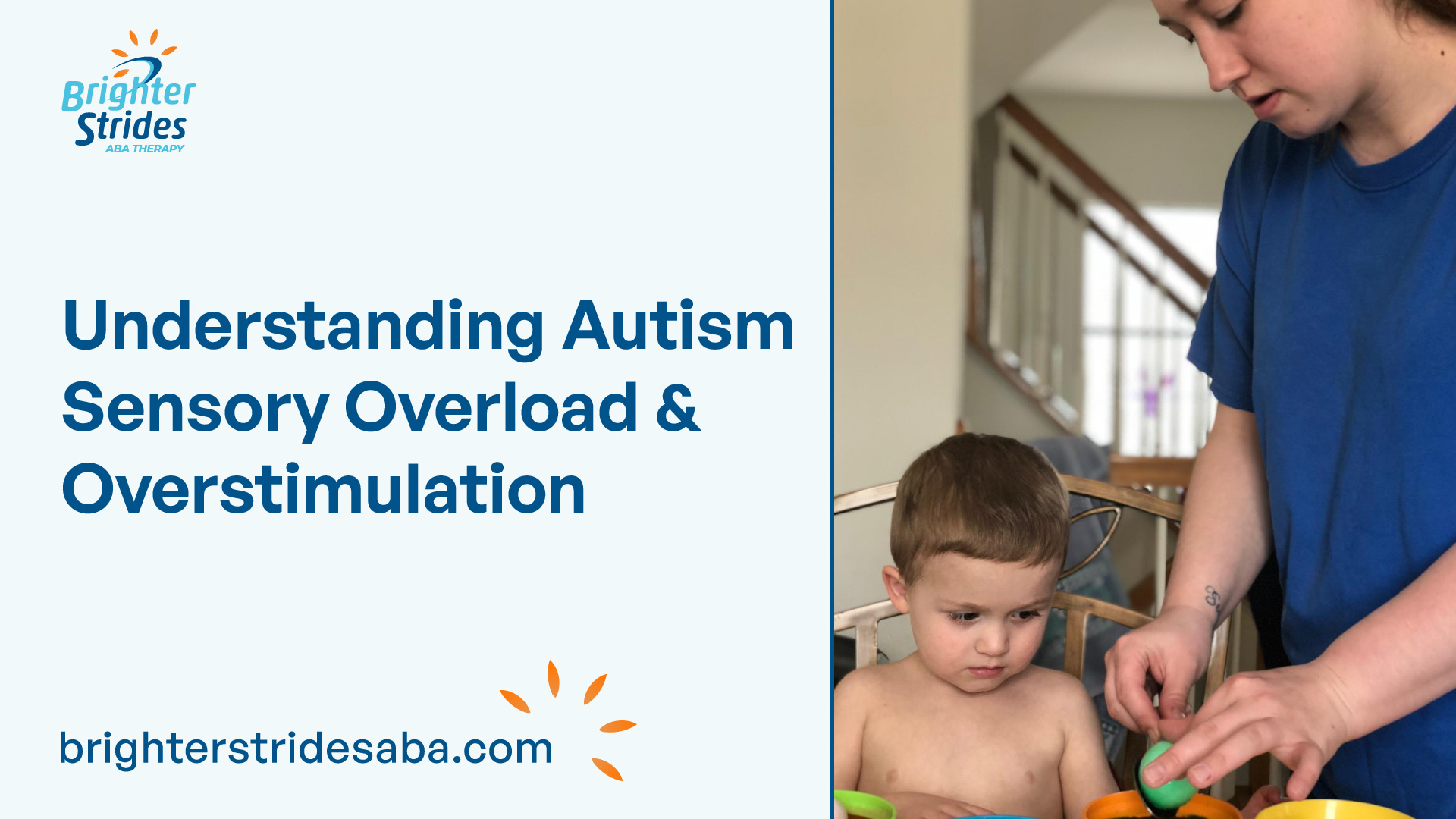Understanding Sensory Overload
Sensory overload is a condition that occurs when one or more of the body’s senses are overstimulated to a point where a person is unable to cope. It happens when the brain receives more information from the senses than it can process. This overwhelming influx of sensory input can lead to a range of emotional and physical responses, causing distress and discomfort for individuals experiencing sensory overload.

Definition and Causes
Sensory overload is a type of sensory processing disorder (SPD), which refers to conditions in which a person is either over-responsive (sensory hypersensitivity) or under-responsive (sensory hyposensitivity) to environmental stimuli. In the case of sensory overload, the individual’s senses become overwhelmed by the intensity, frequency, or complexity of sensory input, making it challenging to filter and interpret the information accurately.
Sensory overload can occur due to various factors, including:
- Loud noises
- Bright or flickering lights
- Strong smells
- Crowded or cluttered environments
- Tactile sensations, such as certain textures or clothing
- Changes in temperature or weather
- Intense emotional situations
These stimuli can trigger an overwhelming response in individuals with sensory processing difficulties, particularly those on the autism spectrum or with attention deficit hyperactivity disorder (ADHD). It’s important to note that sensory overload can affect individuals of all ages, including both children and adults with varying levels of support needs.
Impact on Individuals
The impact of sensory overload can vary from person to person. Some common experiences and effects of sensory overload include:
- Irritability and restlessness
- Anxiety or panic
- Emotional distress, including meltdowns or shutdowns
- Difficulties with attention and concentration
- Sensory-seeking or sensory-avoiding behaviors
- Self-harming behaviors, such as head banging, self-scratching, or self-hitting
For individuals with autism, sensory overload can be particularly challenging. It can lead to difficulties in communication, social interaction, and daily functioning. The overwhelming sensory input may hinder their ability to engage in tasks or activities, resulting in increased stress and frustration.
Understanding and recognizing sensory overload is crucial in supporting individuals who experience it. Strategies, interventions, and support systems can help individuals manage and cope with sensory overload, enabling them to navigate their surroundings more comfortably and participate fully in daily life activities.
Sensory Overload in Autism
Sensory overload is a common experience among individuals with autism, particularly in children. It is a condition where the brain receives an overwhelming amount of sensory information and struggles to process it effectively. This can result in various challenges for autistic individuals, impacting their daily lives and overall well-being.
Prevalence in Autistic Children
Sensory overload is most common in autistic children, as stated by Verywell Health. Over 96% of children with Autism Spectrum Disorder (ASD) report hypersensitivity (over-responsiveness) and hyposensitivity (under-responsiveness) to various sensory stimuli. These sensory issues are included in the diagnostic criteria for ASD.
Children with ASD may experience sensory overload in multiple domains, such as auditory, tactile, and visual. The reactions to sensory overload can vary from mild to severe and may persist into adulthood.
Sensory Processing Disorders (SPDs)
Sensory processing concerns have long been recognized as a defining feature of ASD. Sensory Processing Disorders (SPDs) are characterized by difficulties in effectively processing and organizing sensory information from the environment. These disorders can manifest as both hypersensitivity and hyposensitivity to various stimuli.
Hypersensitivity refers to an over-responsiveness to sensory input. Autistic individuals with hypersensitivity may experience intense discomfort or distress from stimuli that others may find tolerable or even unnoticeable. Common hypersensitivities include sensitivity to noise, bright lights, certain textures, or strong smells.
On the other hand, hyposensitivity refers to an under-responsiveness to sensory input. Autistic individuals with hyposensitivity may seek out intense sensory experiences or engage in repetitive behaviors to stimulate their senses. They may have a higher tolerance for stimuli that others may find overwhelming.
It is important to note that most individuals with autism have a combination of both hypersensitivity and hyposensitivity, with varying degrees of intensity and specific sensitivities.
Understanding sensory overload and sensory processing disorders in autism is crucial for developing effective strategies and interventions to support autistic individuals in managing their sensory experiences and promoting their overall well-being.
Coping Mechanisms
When faced with sensory overload and overstimulation, autistic individuals often employ coping mechanisms to regulate their sensory experiences. Two common coping mechanisms are stimming and self-soothing, as well as various behavioral responses.
Stimming and Self-Soothing
Stimming, also known as self-stimulatory behavior, is a classic response to sensory overload in autistic individuals. Stimming involves engaging in repetitive behaviors that serve as both distractions and self-soothing techniques. Examples of stimming behaviors include hand-flapping, rocking, repeating words or phrases, or sitting on the floor and spinning.
Many autistic individuals use stimming as a way to seek sensory input and balance their sensory systems. These repetitive movements, sounds, or fidgeting actions can help them stay calm, relieve stress, or block out uncomfortable sensory stimuli. Stimming can be a valuable tool for self-regulation and emotional well-being. However, it’s important to note that suppressing stimming in certain settings, such as the workplace, can lead to difficulties in self-regulation and potentially result in sensory overload, exhaustion, or burnout.
Self-soothing techniques are also commonly employed by autistic individuals to manage sensory overload. These techniques may include deep breathing exercises, seeking quiet or secluded spaces, using weighted blankets or pressure vests, or engaging in activities that provide comfort and relaxation. By engaging in self-soothing behaviors, autistic individuals can regain a sense of calm and reduce the impact of sensory overload on their well-being.
Behavioral Responses
Sensory Overload can manifest in various emotional and behavioral reactions in individuals with autism. These responses are often attempts to cope with or escape from overwhelming sensory stimuli.
Some common behavioral responses to sensory overload include meltdowns, withdrawal, repetitive behaviors, or aggression. These behaviors serve as ways to regulate or manage the sensory input that can be overwhelming for individuals with autism.
It’s important to recognize that these behavioral responses are not deliberate or willful actions but rather a result of the challenges posed by sensory overload. Understanding the underlying sensory sensitivities and challenges can help develop strategies to support individuals with autism in managing sensory overload effectively. By creating environments that accommodate sensory needs and providing appropriate support, the impact of sensory overload can be minimized, allowing individuals with autism to thrive.
Coping mechanisms like stimming, self-soothing, and behavioral responses are integral to how individuals with autism navigate sensory overload and overstimulation. By embracing and understanding these coping mechanisms, we can empower autistic individuals and create inclusive environments that promote their well-being and overall quality of life.
Sensory Sensitivities
In individuals with autism, sensory sensitivities are a common occurrence and are included in the diagnostic criteria for autism spectrum disorder. Autistic individuals may experience both hypersensitivity (over-responsiveness) and hyposensitivity (under-responsiveness) to various stimuli. These sensitivities can significantly impact their daily lives and interactions with the environment.
Hypersensitivity in Autism
Hypersensitivity refers to an over-responsiveness to sensory stimuli. Autistic individuals may exhibit hypersensitivity to bright lights, specific light wavelengths, sounds, smells, textures, and tastes. This heightened sensitivity can lead to sensory avoidance behaviors, such as pulling away from physical touch or loud sounds, in an attempt to protect themselves from overwhelming sensations.
Some common examples of hypersensitivity in autism include:
- Auditory hypersensitivity: Individuals may find certain sounds, such as loud noises or high-pitched sounds, extremely distressing. This can result in covering ears, avoiding noisy environments, or becoming overwhelmed in crowded places.
- Visual hypersensitivity: Bright lights or specific light wavelengths can cause discomfort or even pain for some autistic individuals. They may seek out dimly lit environments or wear sunglasses to reduce sensory input.
- Tactile hypersensitivity: Certain textures or physical touch can be aversive for individuals with tactile hypersensitivity. They may be sensitive to clothing tags, seams, or certain fabrics, leading to discomfort or sensory overload.
Hyposensitivity in Autism
Hyposensitivity, on the other hand, refers to under-responsiveness or a decreased sensitivity to sensory input. Autistic individuals with hyposensitivity may seek out intense sensory experiences to compensate for the reduced sensory input they receive. This can manifest as a constant need for movement, difficulty recognizing sensations like hunger or pain, and attraction to loud noises, bright lights, and vibrant colors.
Some common examples of hyposensitivity in autism include:
- Vestibular hyposensitivity: Autistic individuals may seek out activities that provide intense vestibular input, such as spinning or jumping, as they may not receive sufficient sensory feedback to maintain balance and body awareness.
- Proprioceptive hyposensitivity: Proprioception refers to the sense of body position and movement. Individuals with proprioceptive hyposensitivity may engage in activities that provide deep pressure or heavy work, like squeezing or pushing objects, to seek out sensory input and regulate their sensory system.
- Oral hyposensitivity: Some autistic individuals may have reduced sensitivity in their mouth and seek out intense flavors, textures, or chewing on objects to fulfill their sensory needs.
Understanding and addressing both hypersensitivity and hyposensitivity is crucial in supporting individuals with autism and managing sensory overload. By recognizing and accommodating these sensory sensitivities, we can create environments that promote comfort and well-being for autistic individuals.
Managing Sensory Overload
When it comes to managing sensory overload in individuals with autism, it is important to implement strategies and interventions that can help reduce the impact of overwhelming sensory input. Additionally, providing support and understanding to individuals experiencing sensory overload is crucial for their well-being and overall quality of life.
Strategies and Interventions
Several strategies and interventions can be employed to help individuals with autism manage sensory overload. These interventions focus on establishing coping strategies to regulate emotional responses to sensory information. Here are four commonly used interventions:
- Physical Activity (PA): Engaging in regular physical activity has been shown to reduce sensory sensitivity among children with autism. Physical activity not only provides an outlet for excess energy but also helps to regulate the sensory system, promoting better sensory integration and self-regulation.
- Sensory Integration Therapy (SIT): Ayres Sensory Integration Therapy (SIT) is an intervention that can be effective in managing sensory overload in individuals with autism. SIT involves engaging in specific activities that target sensory processing difficulties, aiming to improve sensory integration and enhance adaptive responses to sensory stimuli.
- Mindfulness-Based Cognitive Therapy (MBCT) and Cognitive Behavioral Therapy (CBT): Although no specific studies on their effects on sensory overload in autism have been found, MBCT and CBT have the potential to be useful in managing sensory overload. These therapies focus on developing mindfulness skills and cognitive strategies to regulate emotional responses and cope with overwhelming sensory experiences
- Environmental Modifications: Making modifications to the environment can also help reduce sensory overload. This may involve creating a calm and quiet space, using visual schedules or timers to provide structure, and implementing sensory-friendly elements such as soft lighting or noise-cancelling headphones.
Implementing a combination of these strategies and interventions can significantly improve an individual’s ability to cope with sensory overload and enhance their overall well-being.
Support for Individuals
Providing support and understanding is essential for individuals experiencing sensory overload. Here are some ways to offer support:
- Education and Awareness: Educate family members, friends, teachers, and caregivers about sensory overload and its impact on individuals with autism. Increasing awareness can help create a supportive and inclusive environment.
- Communication: Encourage open communication with the individual about their sensory experiences. Listen to their needs and preferences, and work together to develop strategies to manage sensory overload effectively.
- Empathy and Patience: Show empathy and patience when an individual is experiencing sensory overload. Understand that their reactions are not intentional but are a response to overwhelming stimuli. Provide reassurance and a safe space for them to regulate their sensory experiences.
- Individualized Support: Recognize that each individual with autism may have different sensory sensitivities and coping mechanisms. Tailor support and accommodations to meet their specific needs and preferences.
By implementing strategies and offering support, individuals with autism can better manage sensory overload and navigate their daily lives with greater ease and comfort.
Sensory Overload in Other Conditions
While sensory overload is commonly associated with autism, it can also occur in other conditions such as ADHD and anxiety disorders. Understanding how sensory overload manifests in these conditions can help individuals and their caregivers better manage and cope with the challenges it presents.
Sensory Overload in ADHD
Individuals with attention deficit hyperactivity disorder (ADHD) may experience sensory overload due to their unusually delicate sensory systems. They can be sensitive to their environments and easily overwhelmed by sensory stimuli. The senses of sight, hearing, touch, smell, and taste can become easily overloaded in individuals with ADHD. This can lead to difficulties in processing information and maintaining focus.
When faced with sensory overload, individuals with ADHD may exhibit symptoms such as increased restlessness, difficulty concentrating, irritability, and impulsivity. It is important for individuals with ADHD to have strategies in place to help manage sensory overload, such as creating a calm and organized environment, using noise-canceling headphones, and incorporating regular breaks to reduce stimulation.
Sensory Overload in Anxiety Disorders
Anxiety disorders can also contribute to sensory overload. Post-traumatic stress disorder (PTSD), for example, can cause intense anxiety, stress, and oversensitivity to surroundings. Individuals with PTSD may be hypervigilant and over-aware of their environment. This heightened awareness can lead to sensory overload in the presence of loud sounds, flashing lights, crowded rooms, or other sensory-rich situations. Additionally, sensory stimuli that resemble those experienced during the traumatic event can trigger intense emotional responses.
Individuals with anxiety disorders may benefit from techniques such as deep breathing exercises, grounding techniques, and exposure therapy to gradually desensitize themselves to triggering stimuli. Creating a safe and calm environment can also help reduce the risk of sensory overload and provide a sense of comfort.
Sensory overload can manifest in various ways across different conditions, impacting individuals differently. It is important to recognize and understand the specific challenges faced by individuals with ADHD or anxiety disorders in order to provide appropriate support and accommodations. By implementing strategies to manage sensory overload, individuals with these conditions can navigate their environments more comfortably and improve their overall well-being.

 We've just released an article!
Check out our blog!
We've just released an article!
Check out our blog!



